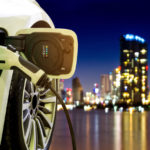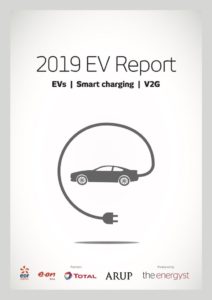 EVs are going to hit the UK in big numbers. The question is when and how should businesses prepare?
EVs are going to hit the UK in big numbers. The question is when and how should businesses prepare?
National Grid has modelled up to 11 million EVs on UK roads in around ten years’ time. In 20 years carmakers will not be allowed to sell petrol and diesel vehicles – possibly sooner. National and local clean air strategies may also expedite change.
Recognising the challenge, carmakers are scrambling to pivot their businesses – and not just their powertrains: Some (Honda, Nissan, VW) have entered the energy sector and more will likely follow.
But, while the Frankfurt Motor Show suggests European EV availability will increase in the next 12-18 months, to retool the automotive industry takes time and a lot of money. For now, electric vehicles and charging infrastructure remains the chicken and egg of our times. Without greater penetration of charging infrastructure, uptake may be dampened. Without the vehicles, infrastructure investors fear demand risk.
Ultimately, car manufacturers will ramp up volumes to crack that conundrum. But businesses and local authorities can play an enabling role – and those surveyed by The Energyst for our 2019 EV Report, display significant appetite to install infrastructure and switch to EVs. So what should they consider?
De-silo
 Start with a cross-company consultation that defines current requirements, a scalable roadmap and delivers benefits for all parties, suggests Matthew Trevaskis, founder of consultancy Ecodrive and former head of electric vehicles at the Renewable Energy Association.
Start with a cross-company consultation that defines current requirements, a scalable roadmap and delivers benefits for all parties, suggests Matthew Trevaskis, founder of consultancy Ecodrive and former head of electric vehicles at the Renewable Energy Association.
For businesses with fleets, those responsible for procurement, fleet management and FM must work more closely, he says. “The earlier that integration happens, the better the outcome tends to be.”
Scalability is another key factor, says Trevaskis, advising businesses to determine their grid capacity, infrastructure requirements and charging profile today and consider how that may change in future.
Grid capacity
EVs will add to grid demand and distribution network constraints. Grid connections are a challenge at around one in four sites, according to Engenie, which is undertaking a national charging rollout for pubco Marston’s.
James Turner, head of propositions at Total Gas & Power, advises businesses that it will “really speed the process if you have a firm view of capacity, whether there is any scope to increase it, and what your actual charging needs are.”
Distribution network operators (DNOs) say they recognise the need to provide better visibility of connections and capacity.
Northern Powergrid is rolling out a mapping tool that shows where businesses and councils can install chargers with or without reinforcement and associated costs.
DNOs such as Western Power Distribution have published costs and lead times for different types of chargers and reinforcement works. WPD said it plans to offer alternative connections where businesses can charge at certain times and avoid exceeding available local capacity.
UK Power Networks is also taking that approach and its commercial services arm is working with fleet companies such as UPS to create smart charging solutions combined with behind-the-meter storage to avoid significant capacity upgrade costs.
While some businesses interviewed suggest it is too early to consider bundling integrated solutions around EVs and on-site generation, around seven in ten organisations surveyed for the EV report said they are at least open to that approach.
While a UK standard has yet to be defined, a smart charging approach will maximise use of existing capacity and infrastructure. That can be as simple as a timed connection to ensure EVs are charged out of peak periods, through to responding to dynamic price signals.
Ultimately, smart charging could develop into vehicle-to building or vehicle-to-grid (V2G) services, where EVs could be used to shift site load out of peak periods, or aggregated into virtual power plants.
Companies such as EDF Energy, Nissan and Ovo-owned Kaluza are bullish on the prospects for V2G, while Pod Point CEO Erik Fairbairn also thinks it is “on the cusp” of commercial viability in certain applications.
Others believe it may be many years before vehicle-to-grid becomes mainstream, if ever. In the meantime, “lets not lose sight of the value of smart charging in the race to V2G”, urges Ecodrive’s Trevaskis.
Vehicle shortages
Chargepoints, smart charging and vehicle-to-grid risk redundancy without greater numbers of EVs. According to the Society of Motor Manufacturers & Traders, ‘pure’ electric vehicle sales, which it terms BEVs, are up around 70 per cent to date in 2019 but remain around 1 per cent of new car sales.
That presents a challenge to institutional investors. Their capital will ultimately be necessary to fund charging infrastructure at the scale required, but they will only see return on investment when chargers are highly utilised. It also poses a problem for businesses that want to buy EVs now – reflected in the rising premium for second hand EVs.
Fleet operators in particular are struggling to secure supply. Mitie has committed to switch 20 per cent of its cars and small vans to EVs by 2020, equating to around 717 vehicles. Fleet and procurement director, Simon King, says visibility from suppliers has been poor.
“We are used to buying 1,500 vehicles a year and having a fairly robust supply chain,” he says. “My biggest ask of car and van manufacturers is: meet with us, commit to supply and provide visibility on what they can deliver through to the end of 2020.”
Leasing companies could also be more proactive, said many of those interviewed for the EV report.
Collect data now
Equally, businesses could better prepare. Those considering EVs, particularly fleet operators, should make data their start point, suggests Teodora Spasova, Associate, Business & Investor Advisory at Arup.
“We have met quite a few fleet owners and generally, they lack good visibility on vehicle usage. When they put telematics on their fleets they have been surprised by the results, but that is the first step,” she says. “In order to provide the best solution, you need to know your travel patterns in detail.”
Filippo Gaddo, director, Economics and Regulation at Arup, says the same applies to energy companies, many of whom are switching their own large fleets to EVs.
“They need to do better data analysis – both usage data and location data, considering where best to put the chargers.”
 If your organisation is considering electric vehicles or charging infrastructure, you should download The Energyst’s EV report.
If your organisation is considering electric vehicles or charging infrastructure, you should download The Energyst’s EV report.
You should also register to attend our free EV Event at Silverstone, 28-29 April 2020.
Related stories:
Kaluza: EVs can displace large scale battery storage
Calling all fleet operators: Free vehicle-to-grid charging infrastructure
Vehicle-to-grid study suggests £400 annual revenue per electric vehicle
Nissan: 2019 a “breakthrough year” for vehicle-to-grid
Mitie: Getting hold of electric vehicles a major challenge
EVs: How UPS is driving down emissions
Electric vehicles: Define smart charging, urge DNOs
Vehicle-to-grid: Are we nearly there yet?
EVs: Car parks sought for V2G trials
National Grid predicts huge solar growth, while EVs create huge storage capacity
Pubs and supermarkets the new petrol stations?
Chargepoint raises £189m to fund EV charging infrastructure
BT and Eon pledge to electrify fleet by 2030
Total partners with Chargepoint to bundle energy and EVs to businesses
Octopus backs flex and EVs for growth
Energy managers to become fleet managers
EV boom no sweat, says National Grid
Flexitricity chief: UK has enough spare power electrify every car on the road
Pivot makes huge play for 2GW storage and EV charging network
‘Land grab’ for EV car parks and revenue
Follow us at @EnergystMedia. For regular bulletins, sign up for the free newsletter.



